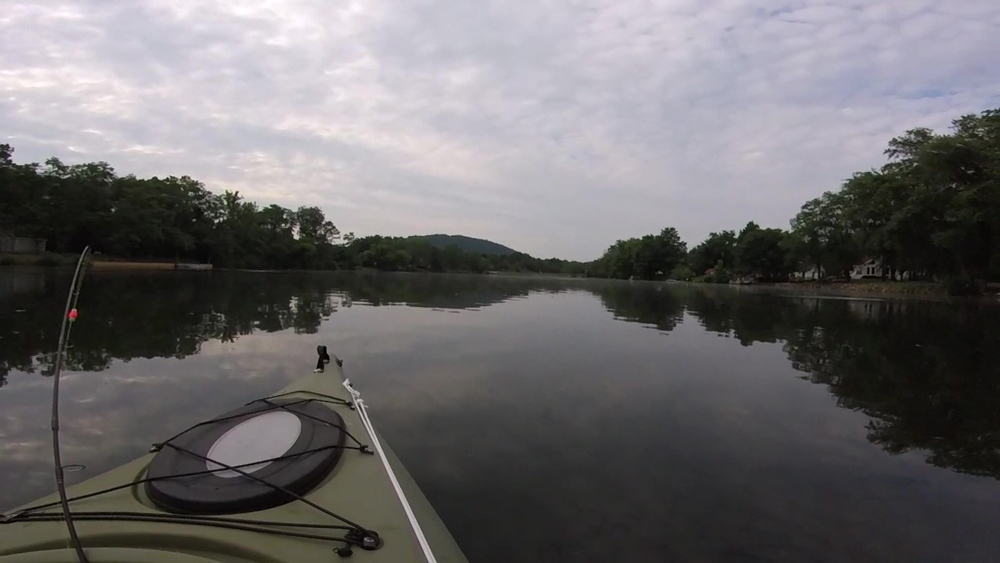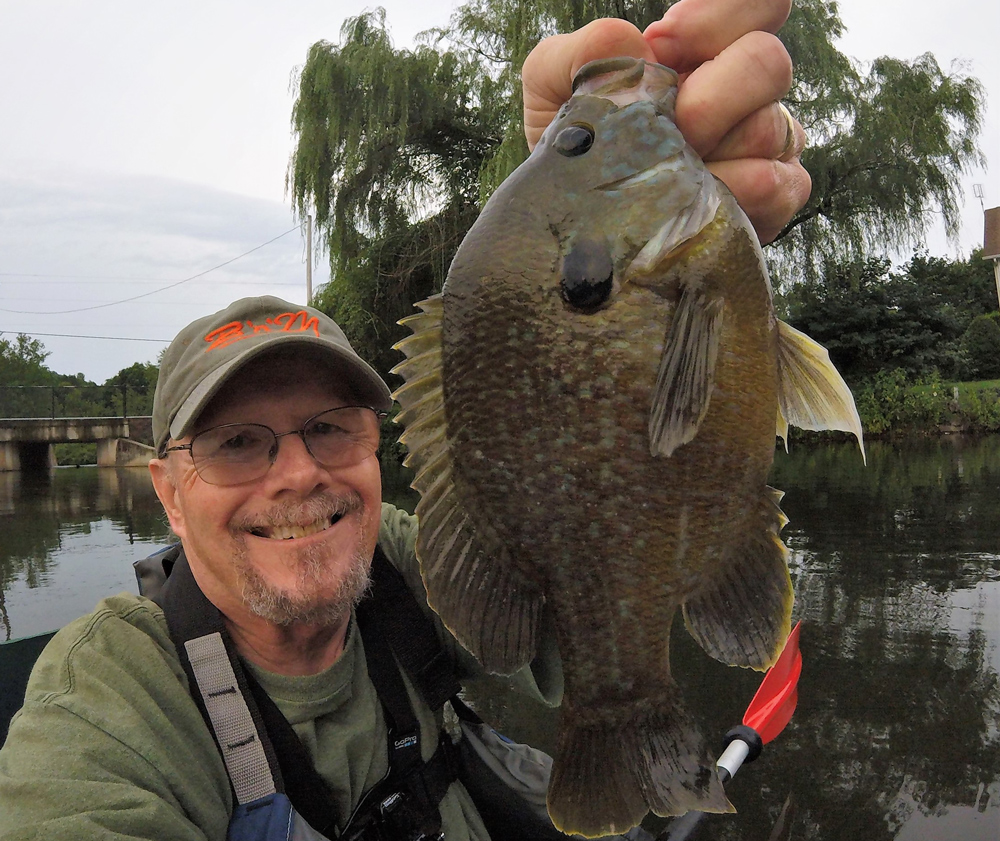An economical sit-in kayak is all you need to go fishing in small, flatwater environs like the DelMarVa Eastern Shore millponds, ideal waters that could put you on bass or panfish. Nothing special – no electronics, just a bare-bones setup with an anchor trolley, paddle bracket, and a base for the GoPro camera. Combined with marginal paddling skills and an ultra-light spinning rod, I find that spawning bluegills and suspended summertime crappies are more than a hoot. The rig also opens some new fishing doors and enables you to catch and release several hundred panfish that might not otherwise been enjoyed.

Many small Mid-Atlantic lakes have unimproved or aging launch facilities, and thus it makes sense to fish them from kayaks. Additionally, overgrown, ultra-shallow shoreline areas that hold spawning sunfish, largemouth bass after the spawn, or ambushing pickerel are often best fished from the confines of a quiet, stealthy yak. Plus, the quiet, sneaky approach with these vessels can often put you on to many dynamite photo ops of wildlife, flora, and fauna.
Of course, these are all things that the kayak fans already know. But as with any new endeavor, there is always an element of excitement and joy, pleasure and relaxation. Panfishing from a yak is just a good gig… period.
Timing Your Kayak Fishing
As a rookie, I try to keep my trips planned around the spawning phases of crappies and bluegills and give a minor effort to the early morning bass bite. As you read this, crappies will be done spawning and will have transitioned back to deeper water, deeper brush, and deeper holes near millpond dam faces. Some will be hanging out in the shallow brush as this years “later than normal” spawn could see the remnants of that activity. But for the most part they will be on deeper structure or even suspended.
Bluegills and sunfish, on the other hand, will be spawning in areas of fine sand and gravel throughout the early summer months, often coinciding with full moon periods of the lunar calendar. Hence, shallow, sight-fishing options will last even as late as August on some waters – provided that algae growth and other aquatic weeds do not impair mid- to late-summer spawning efforts. Good polarized glasses are a plus when scouting for spawning gills, and are essential for spotting cruising bass or other targets in the shallows.
Timing, on a daily schedule, is also important. You’ll enjoy quality pan-fishing from 6 a.m. up until about noon during June, July and August. Fishing during the coolest part of the day coupled with insect activity and increased feeding seems to be the ideal timing for fishing success, and it also gets us out of the heat of the day when those 90-plus temperatures settle in. Cooler overcast mornings are both pleasant on the body and ideal for catching a kayak-load of bluegills.
Kayak Fishing Tackle
Personally, I like to carry a pair of shorter, ultra-light spinning sticks at five to six feet in length, which enable me to cast up and under the overhanging canopy of shoreline trees and vegetation. Longer rods make this tough, but they, too, have their own application, especially if you are fishing more open areas with little tree cover.
Classic four-pound test limp monofilament covers most bases for the panfish gig. However, if you are in a lot of brush or weeds then you can up it to six-pound line or even 10-pound braid if you foresee the chance of a big largemouth, pickerel, or even a snakehead.
Almost all of our pan-fishing is done with small 1/32nd and 1/64th ounce jigs, either of the hair variety or trimmed with plastics. The Bobby Garland Itty Bit and Itty Bit Swim’r are good trailers to use on smaller jigs, or the classic tiny one-inch Mister Twisters. Many others work and everybody has their personal favorite. At times, panfish may be fussy and live bait tipping options may be needed to coax strikes. Small pieces of garden worms get the call, as do meal worms. During the summer heat, any earthworm type can stress and suffer from high temperatures, becoming lethargic and un-appealing to the fish. If you don’t have a small cooler keep them cool, then a better option would be the meal worms or even a variety of the Berkley GULP! products like the Crappie Nibbles, Angle Worms or the one-inch Minnows.

Often, we suspend these jigs and baits below small, oval floats like the Plasti-Lite 3/4 inch oval snap-on float. If fish are suspended, then you can add BB-sized split-shot a foot or so up the line and cast to deeper structure and look for strikes or thumps on the fall. Don’t be afraid to use high-visibility lines to help you see those ticks and jumps in the line, indicting a strike.
Accessories
I tend to travel as light as I can for kayak pan-fishing, carrying all my jigs, lures, and live baits in a canvas pouch or even a vest. I have ample pockets on my PFD, which I wear constantly, and can carry most terminal gear there as well. A net may be needed, especially if you are expecting the possibility of a bigger bass. And if you are keeping fish, a fish basket or small cooler would do well to keep your fish fresh. Sunscreen, polarized sunglasses, insect repellent, and loose-fitting clothing will all help make your outing for warm-weather panfish more enjoyable. I sometimes also wear camo clothing, especially if I know I am going to be fishing in shallow water where fish could be spooky.
Additionally, bring some snacks and cold water to stay hydrated – and it’s always a good idea to fish with a friend, especially if you’re fishing on an unfamiliar body of water. Be aware of what you are capable of as a paddler, and do not extend yourself physically in the heat.
Yes, bluegills, crappies, white perch and more are all easy targets for the kayak angler – so enjoy the bounty and beauty this summer!
- Jim Gronaw